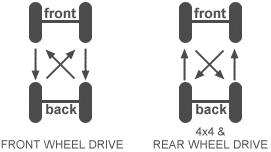
Tyre wear varies depending on where it is fitted. If a
car is front wheel drive then the fronts will wear out a lot quicker
than the rear ones, the rear tyres can do twice as many miles to the
front. If your car is rear wheel drive, then the rears will wear a
little faster although there isn't a lot of difference from front to
back with these cars. Another thing that has been observed is the
passenger side front tyre also wears out a little quicker than the
right. In most cases tyre life can be increased by the occasional switch
around. One thing to remember is that changing from front to back can
have safety implications especially if they are delayed in being
switched.
Most people would normally opt for new tyres or the ones that have more tread to be fitted to the front of the car. When in actual fact they should be fitted to the rear. If the front has better grip then the rear there is a risk of an accident, the vehicle could spin or swerve especially in wet conditions. Tyre safety organizations recommend that all new tyres should be fitted on the rear axle first. If you are switching old tyres around then bearing the above in mind the rear tyres should be in better or the same condition as the front.
Tyres that have a rotation marking cannot be switched from the drivers side to the passengers side or vice versa. You would have to demount the tyre from the rim and switch the rotation to do that. Otherwise they can only be moved from back to front and not side to side.
Manufacturers differ on when you should switch tyres around, although most commonly it is suggested you make the switch every 2000 to 3000 miles.
Please be aware that some cars have a different front size to the rear, in this case no switch around can be made.